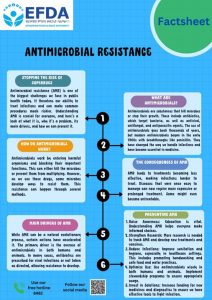
Antimicrobials are medications, such as antibiotics, that kill or control disease-causing bacteria. Antimicrobial resistance (AMR) arises when microorganisms evolve or adapt in ways that allow them to resist antimicrobials, making treatments ineffective. The overuse and misuse of antimicrobials, particularly antibiotics, in humans and animals accelerate Antimicrobials significantly.
The ability of microorganisms, including bacteria, viruses, fungi, and parasites, to withstand the effects of drugs that once effectively treat them is known as antimicrobial resistance (AMR), and it represents a serious global public health concern. Longer hospital stays, more medical expenses and higher mortality rates can result from this resistance.
Overuse and misuse of antibiotics can result in antimicrobial resistance. Resistance develops as a result of self-medication, patient non-compliance, and inappropriate prescribing methods in healthcare settings. The use of antibiotics in animals to promote growth and prevent sickness can result in resistant strains that could spread to people through the food chain. It can also be caused by agricultural activities.
Hence, antimicrobial resistance affects people in different ways. Because infections brought on by resistant organisms are more difficult to cure, they can result in longer disease durations, a higher risk of complications, and higher mortality rates. Furthermore, it has a financial cost. The financial impact includes significant loss of productivity owing to illness, the need for more costly medications, and increased healthcare costs as a result of longer hospital admissions.
Here the most crucial question in this case is whether or not antibiotic resistance affects the environment. If it involves environmental issues, how might it be resolved?
Ethiopian Food and Drug Authority Drug Pharmacovigilance and Clinical Trial Lead Executive Officer Asnakech Alemu told the Ethiopian Herald that the World Health Organization (WHO) has launched a Global Action Plan on Antimicrobial Resistance, which aims to improve surveillance, research and development, infection prevention and control, and antimicrobial use.

Taking these facts into account, the country has been implementing national action plans to respond to antimicrobial resistance. These plans mainly focus on improving stewardship programs, enhancing laboratory capacity, and promoting public awareness campaigns.
Taking these facts into account, the country has been adopting national action plans to combat antimicrobial resistance. These strategies primarily aim to improve public health and promote public awareness campaigns. Particularly, antimicrobial resistance is not only a critical public health concern but also has serious environmental consequences. its relationship with the environment is complicated and multidimensional, with multiple avenues for resistant microbes and antimicrobial drugs to enter and harm ecosystems.
She also stated that environmental pollution may result from antibiotic resistance. Manufacturing pharmaceuticals could be a good example of this. High levels of antibiotics and resistant microorganisms in wastewater from pharmaceutical production sites can contaminate the environment. Antimicrobial resistance also affects agricultural runoff. Antibiotic residues and resistant bacteria can enter soil and water bodies through runoff from the use of antibiotics in crop and livestock agriculture. Antimicrobial resistance can also be found in wastewater treatment facilities. Antibiotics and resistant microbes might not be completely eliminated by these facilities, allowing them to be reintroducedback into the environment.
Furthermore, antimicrobial resistance has detrimental consequences for ecosystems. The presence of antibiotics in the environment can disturb microbial populations, resulting in decreased biodiversity and altered ecosystem processes. Certain resistant strains may outcompete indigenous species, disrupting the balance of microbial ecosystems which leads to a loss of biodiversity.
She noted that antimicrobial resistance does not just impair biodiversity; it can also have an impact on soil health. Antibiotics can have an impact on soil microbiomes, which are important for nutrient cycling, organic matter decomposition, and soil fertility. Disruptions to these systems can have long-term effects on agricultural yield. Furthermore, it has an impact on water quality since contaminated water bodies can host resistant bacteria, endangering aquatic life and potentially contaminating drinking water supplies. This can result in a cycle of transmission to humans and animals.
Antimicrobial resistance in the environment can impede efforts to manage infectious diseases because resistant organisms can infiltrate human populations through a variety of paths, including food consumption, recreational aquatic activities, and contact with contaminated surfaces.
She said that to decrease antibiotic resistance and its environmental implications, sustainable agriculture techniques must be implemented. Antibiotic use in agriculture can be reduced by better management methods, such as improved animal husbandry and biosecurity. It is also improving wastewater treatment technologies to better remove antibiotics and resistant bacteria before they are discharged into the environment. Furthermore, it is critical to upgrade infrastructure to ensure access to water and sanitation in healthcare facilities. Effective treatment and disposal of sewage and wastewater can help to reduce antibiotic resistance.
It is also critical to enhance waste management procedures in health stations, hospitals, and so on. Improving the safe disposal of unneeded antimicrobials, as well as monitoring the presence of antimicrobial residues, antibiotic-resistant bacteria, sanitation systems, and genes in health facilities, can assist in mitigating environmental impacts.
More importantly, antimicrobial resistance and its consequences, including environmental impacts, necessitate a One Health approach, which acknowledges the interconnection of human, animal, and environmental health. To effectively address antimicrobial resistance, it is necessary to identify and mitigate its environmental pathways, as well as manage its dissemination in clinical settings. Collaboration across sectors is vital for developing long-term solutions that safeguard both public health and the environment, she underlined.
Furthermore, adopting programs that promote the proper use of antimicrobials in both healthcare and agriculture is critical to reducing the long-term consequences of antimicrobial resistance. The government, the people, and healthcare workers should all work together to prevent infections. They should improve cleanliness practices, immunization programs, and infection control measures in healthcare facilities. It is critical to raise public knowledge about the dangers of antibiotic abuse and the need to follow prescribed treatment regimens.
The issue of antimicrobial resistance is a complicated and growing threat that requires immediate action. Understanding past preventative efforts is critical for implementing effective problem-solving solutions. With adequate funding, inventive thinking, and strengthened international cooperation, the world has a chance of preserving these critical medications for future generations she added
BY EPHREM ANDARGACHEW
THE ETHIOPIAN HERALD WEDNESDAY 20 NOVEMBER 2024





